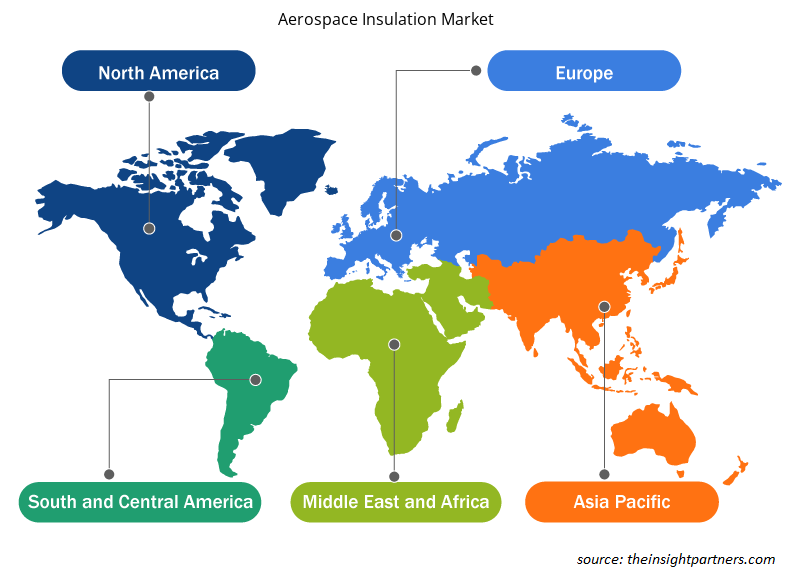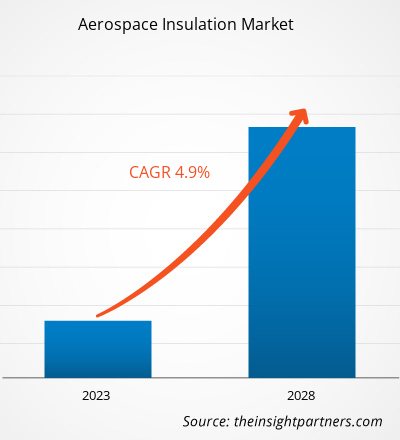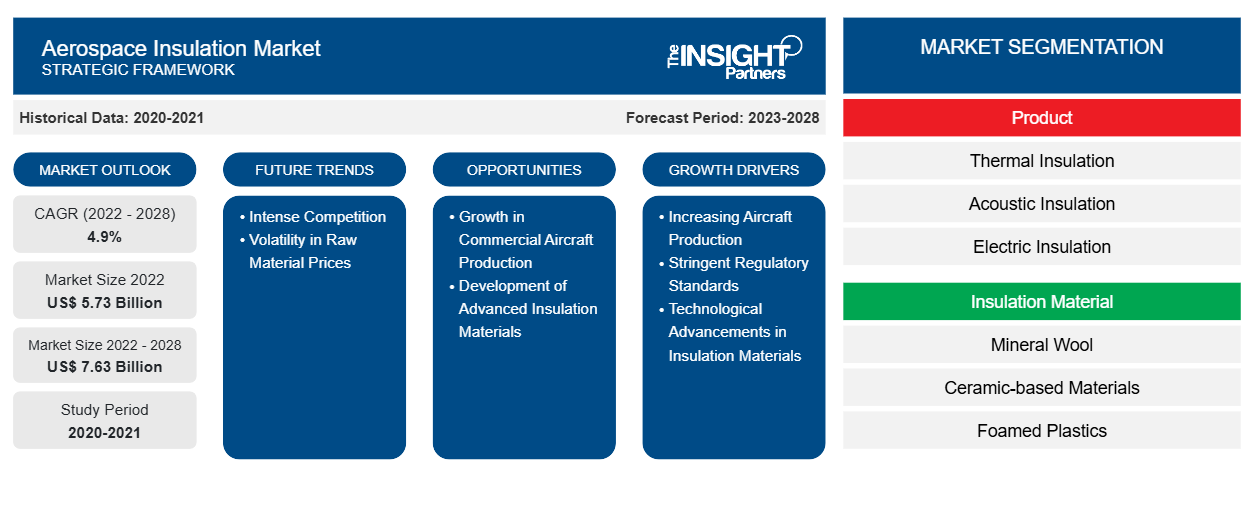Se espera que el mercado de aislamiento aeroespacial crezca de US$ 5.731,28 millones en 2022 a US$ 7.633,23 millones en 2028; se estima que crecerá a una CAGR del 4,9% entre 2022 y 2028.
El aislamiento aeroespacial se refiere al material instalado en la aeronave para mejorar los niveles de seguridad y comodidad. Las funciones de la aeronave en condiciones climáticas severas deben cumplir con ciertas operaciones fundamentales, así como con las medidas de seguridad relacionadas con el peso y la temperatura y el rendimiento general. Debido a las ventajas, como los niveles más bajos de vibración y ruido durante las horas de vuelo, la demanda de materiales aislantes está creciendo a un ritmo rápido. Se espera que el uso creciente de materiales compuestos en aeronaves comerciales impulse el desarrollo de diversas aeroestructuras , lo que dará como resultado un potencial industrial sustancial. Es probable que la creciente demanda de materiales aislantes livianos y materiales compuestos en las industrias de aeronaves comerciales y jets ejecutivos para reducir el ruido de la cabina impulse el mercado en los próximos años.
El aislamiento aeroespacial desempeña un papel crucial en la protección de la tripulación y los pasajeros del ruido de los generadores y las temperaturas gélidas a mayores altitudes. Se espera que la creciente demanda de flotas ligeras, aeronaves de nueva generación y de bajo consumo de combustible, junto con la creciente importancia de la reducción de las emisiones, aumente la producción de aeronaves. El importante desarrollo de la industria de los viajes en los mercados emergentes y el creciente número de pasajeros en viajes internacionales y nacionales son los principales factores que impulsan el mercado mundial del aislamiento aeroespacial . Por ejemplo, según la Asociación Internacional de Transporte Aéreo ( IATA ), la demanda total de viajes aéreos en abril de 2022 aumentó un 78,7% en comparación con abril de 2021.
Personalice este informe según sus necesidades
Obtendrá personalización en cualquier informe, sin cargo, incluidas partes de este informe o análisis a nivel de país, paquete de datos de Excel, así como también grandes ofertas y descuentos para empresas emergentes y universidades.
- Obtenga las principales tendencias clave del mercado de este informe.Esta muestra GRATUITA incluirá análisis de datos, desde tendencias del mercado hasta estimaciones y pronósticos.
Según la Administración Federal de Aviación (FAA), todos los aviones comerciales deben contar con aislamiento térmico y acústico. Estos aislantes garantizan que el confort de los pasajeros no se vea afectado por las variaciones de temperatura exterior y que el ruido excesivo que genera el avión no interfiera en la comunicación. Estas estrictas regulaciones animan a los fabricantes de aviones a utilizar material aislante en sus aeronaves, lo que impulsa el mercado de aislamientos aeroespaciales.
Muchos fabricantes de aislamientos aeroespaciales, como Zotefoams, están desarrollando materiales de construcción aeroespaciales livianos para aumentar la eficiencia del combustible y la sostenibilidad. El aislamiento térmico y acústico protege contra el ruido y la temperatura excesivos en la mayoría de las aeronaves. El aislamiento térmico y acústico es una fibra única de alto rendimiento envuelta en una cubierta de plástico apta para aeronaves que mantiene unidos los materiales aislantes y, al mismo tiempo, funciona como barrera contra la humedad.
Perspectivas del mercado
El crecimiento del sector del transporte aéreo impulsa el mercado del aislamiento aeroespacial
El sector del transporte aéreo se está expandiendo rápidamente y se espera que continúe así durante los próximos años. Según la estimación de la Asociación Internacional de Transporte Aéreo ( IATA ), se espera que la demanda de transporte aéreo aumente en un promedio del 4,3% anual hasta 2036. Si este crecimiento se logra para 2036, se espera que la industria del transporte aéreo contribuya con 15,5 millones de empleos directos y 1,5 billones de dólares de PIB a la economía mundial durante el período de pronóstico. Un crecimiento tan significativo en la demanda de transporte aéreo conducirá a una mayor demanda de aeronaves. El aislamiento aeroespacial se utiliza en las aeronaves para aumentar la comodidad y la seguridad de las aeronaves y los viajeros, lo que se espera que impulse el mercado del aislamiento aeroespacial durante el período de pronóstico. Además, el costo de los materiales compuestos está disminuyendo continuamente, lo que permite a los fabricantes de aeronaves utilizar compuestos para el aislamiento aeroespacial. Por lo tanto, debido a estos factores, el mercado florecerá rápidamente durante el período de pronóstico.
Información sobre el producto
Según el producto, el mercado de aislamiento aeroespacial se segmenta en aislamiento térmico, aislamiento acústico, aislamiento eléctrico y aislamiento de vibraciones. En 2021, el segmento de aislamiento térmico dominó el mercado y se espera que crezca a una CAGR más rápida durante el período de pronóstico. El aumento de las actividades de investigación y desarrollo para producir material de aislamiento térmico avanzado, liviano y sostenible está impulsando el crecimiento del segmento de aislamiento térmico durante el período de pronóstico.
3M; TransDigm Group Incorporated; Triumph Group, Inc.; Johns Manville ; Morgan Advanced Materials Plc ; Polymer Technologies Inc.; Duracote Corporation; Rogers Corporation; DuPont; y BASF SE son los actores clave que operan en el mercado de aislamiento aeroespacial. Los actores líderes adoptan varias estrategias, como fusiones y adquisiciones y lanzamientos de productos, para expandir su presencia geográfica y su base de consumidores.
Perspectivas regionales del mercado de aislamiento aeroespacial
Los analistas de Insight Partners explicaron en detalle las tendencias y los factores regionales que influyen en el mercado de aislamiento aeroespacial durante el período de pronóstico. Esta sección también analiza los segmentos y la geografía del mercado de aislamiento aeroespacial en América del Norte, Europa, Asia Pacífico, Oriente Medio y África, y América del Sur y Central.

- Obtenga datos regionales específicos para el mercado de aislamiento aeroespacial
Alcance del informe sobre el mercado de aislamiento aeroespacial
| Atributo del informe | Detalles |
|---|---|
| Tamaño del mercado en 2022 | 5.730 millones de dólares estadounidenses |
| Tamaño del mercado en 2028 | US$ 7.63 mil millones |
| CAGR global (2022-2028) | 4,9% |
| Datos históricos | 2020-2021 |
| Período de pronóstico | 2023-2028 |
| Segmentos cubiertos | Por producto
|
| Regiones y países cubiertos | América del norte
|
| Líderes del mercado y perfiles de empresas clave |
|
Densidad de actores del mercado de aislamiento aeroespacial: comprensión de su impacto en la dinámica empresarial
El mercado de aislamiento aeroespacial está creciendo rápidamente, impulsado por la creciente demanda de los usuarios finales debido a factores como la evolución de las preferencias de los consumidores, los avances tecnológicos y una mayor conciencia de los beneficios del producto. A medida que aumenta la demanda, las empresas amplían sus ofertas, innovan para satisfacer las necesidades de los consumidores y aprovechan las tendencias emergentes, lo que impulsa aún más el crecimiento del mercado.
La densidad de actores del mercado se refiere a la distribución de las empresas o firmas que operan dentro de un mercado o industria en particular. Indica cuántos competidores (actores del mercado) están presentes en un espacio de mercado determinado en relación con su tamaño o valor total de mercado.
Las principales empresas que operan en el mercado de aislamiento aeroespacial son:
- Corporación Duracote
- Corporación Rogers
- DuPont
- BASF SE
- 3M
Descargo de responsabilidad : Las empresas enumeradas anteriormente no están clasificadas en ningún orden particular.

- Obtenga una descripción general de los principales actores clave del mercado de aislamiento aeroespacial
Informe Destacado
- Tendencias progresivas en la industria del aislamiento aeroespacial para ayudar a los actores a desarrollar estrategias efectivas a largo plazo
- Estrategias de crecimiento empresarial adoptadas por las empresas para asegurar el crecimiento en los mercados desarrollados y en desarrollo
- Análisis cuantitativo del mercado mundial de aislamiento aeroespacial de 2021 a 2028
- Estimación de la demanda de aislamiento aeroespacial en diversas industrias
- Análisis de las cinco fuerzas de Porter para ilustrar la eficacia de los compradores y proveedores que operan en la industria del aislamiento aeroespacial
- Desarrollos recientes para comprender el escenario competitivo del mercado y la demanda de aislamiento aeroespacial
- Tendencias y perspectivas del mercado junto con los factores que rigen el crecimiento del mercado de aislamiento aeroespacial
- Comprender las estrategias que sustentan el interés comercial con respecto al crecimiento del mercado, ayudando en el proceso de toma de decisiones.
- Tamaño del mercado de aislamiento aeroespacial en varios nodos del mercado
- Descripción detallada y segmentación del mercado, así como de su dinámica industrial.
- Tamaño del mercado de aislamiento aeroespacial en varias regiones con oportunidades de crecimiento prometedoras
El "Análisis del mercado de aislamiento aeroespacial hasta 2028" es un estudio especializado y profundo de la industria de productos químicos y materiales, que se centra en el análisis de tendencias del mercado. El informe tiene como objetivo proporcionar una descripción general del mercado con una segmentación detallada. El mercado de aislamiento aeroespacial está segmentado en función del producto, el material de aislamiento, la aeronave y la geografía. Según el producto, el mercado se segmenta en aislamiento térmico, aislamiento acústico, aislamiento eléctrico y aislamiento de vibraciones. Según el material de aislamiento, el mercado se segmenta en lana mineral, materiales a base de cerámica, plásticos espumados y fibra de vidrio, entre otros. Según la aeronave, el mercado se segmenta en motor y fuselaje. Según la geografía, el mercado se segmenta en cinco regiones principales: América del Norte, Europa, Asia Pacífico, Oriente Medio y África, y América del Sur y Central. En 2021, América del Norte dominó el mercado. Sin embargo, se espera que Asia Pacífico registre la CAGR más alta del mercado durante el período de pronóstico.
- Análisis histórico (2 años), año base, pronóstico (7 años) con CAGR
- Análisis PEST y FODA
- Tamaño del mercado, valor/volumen: global, regional y nacional
- Industria y panorama competitivo
- Conjunto de datos de Excel
Informes recientes
Informes relacionados
Testimonios
Razón para comprar
- Toma de decisiones informada
- Comprensión de la dinámica del mercado
- Análisis competitivo
- Información sobre clientes
- Pronósticos del mercado
- Mitigación de riesgos
- Planificación estratégica
- Justificación de la inversión
- Identificación de mercados emergentes
- Mejora de las estrategias de marketing
- Impulso de la eficiencia operativa
- Alineación con las tendencias regulatorias























 Obtenga una muestra gratuita para - Mercado de aislamiento aeroespacial
Obtenga una muestra gratuita para - Mercado de aislamiento aeroespacial